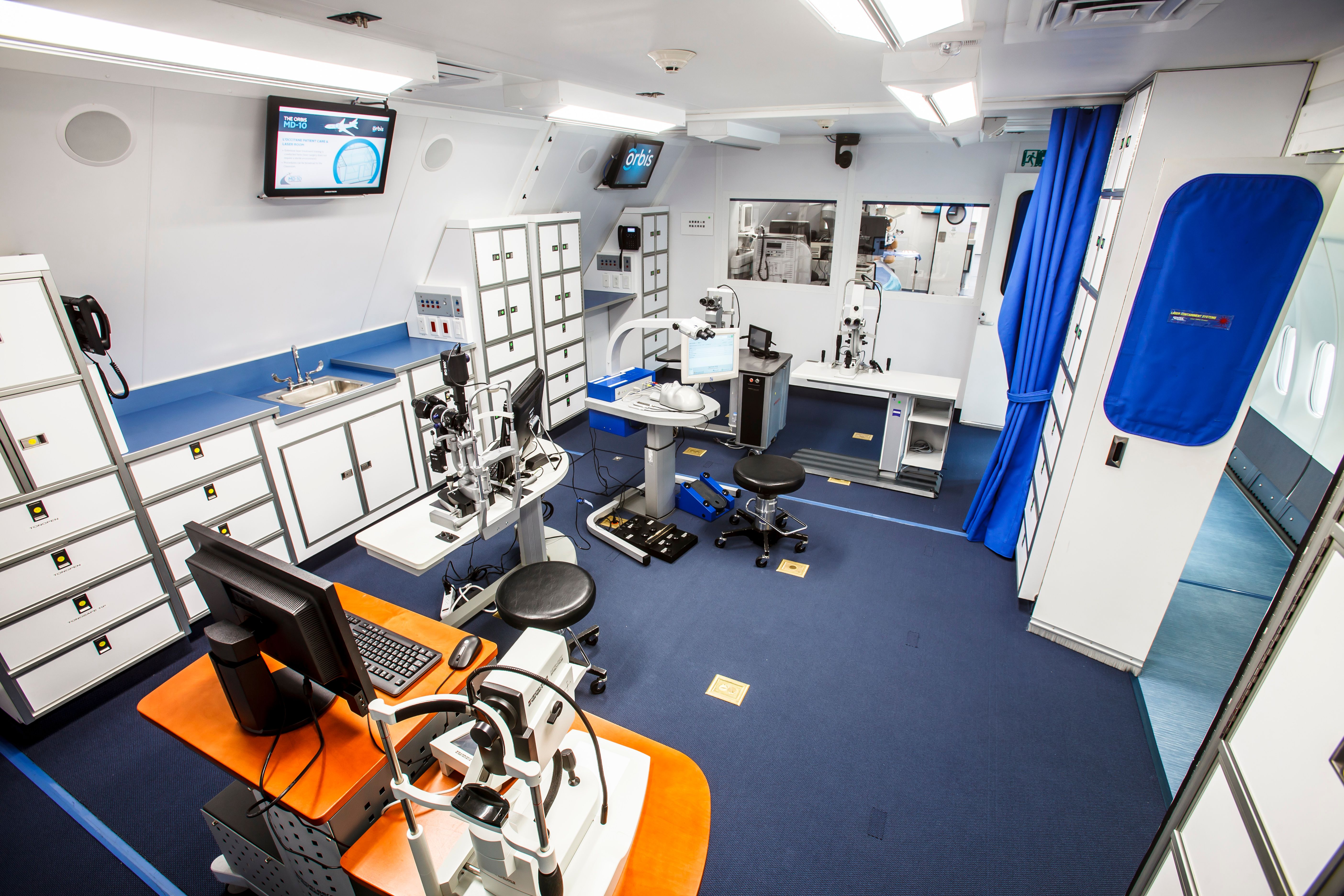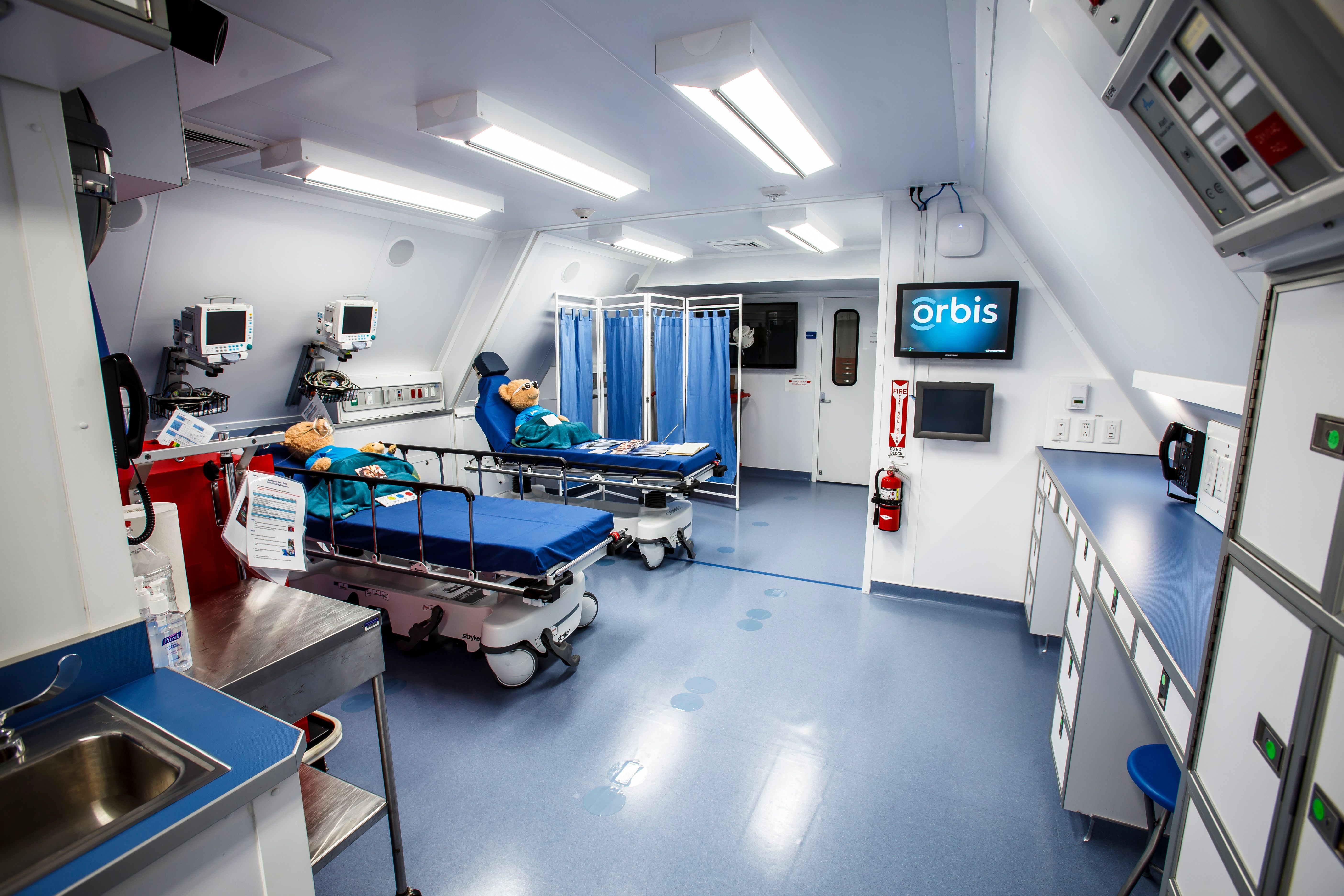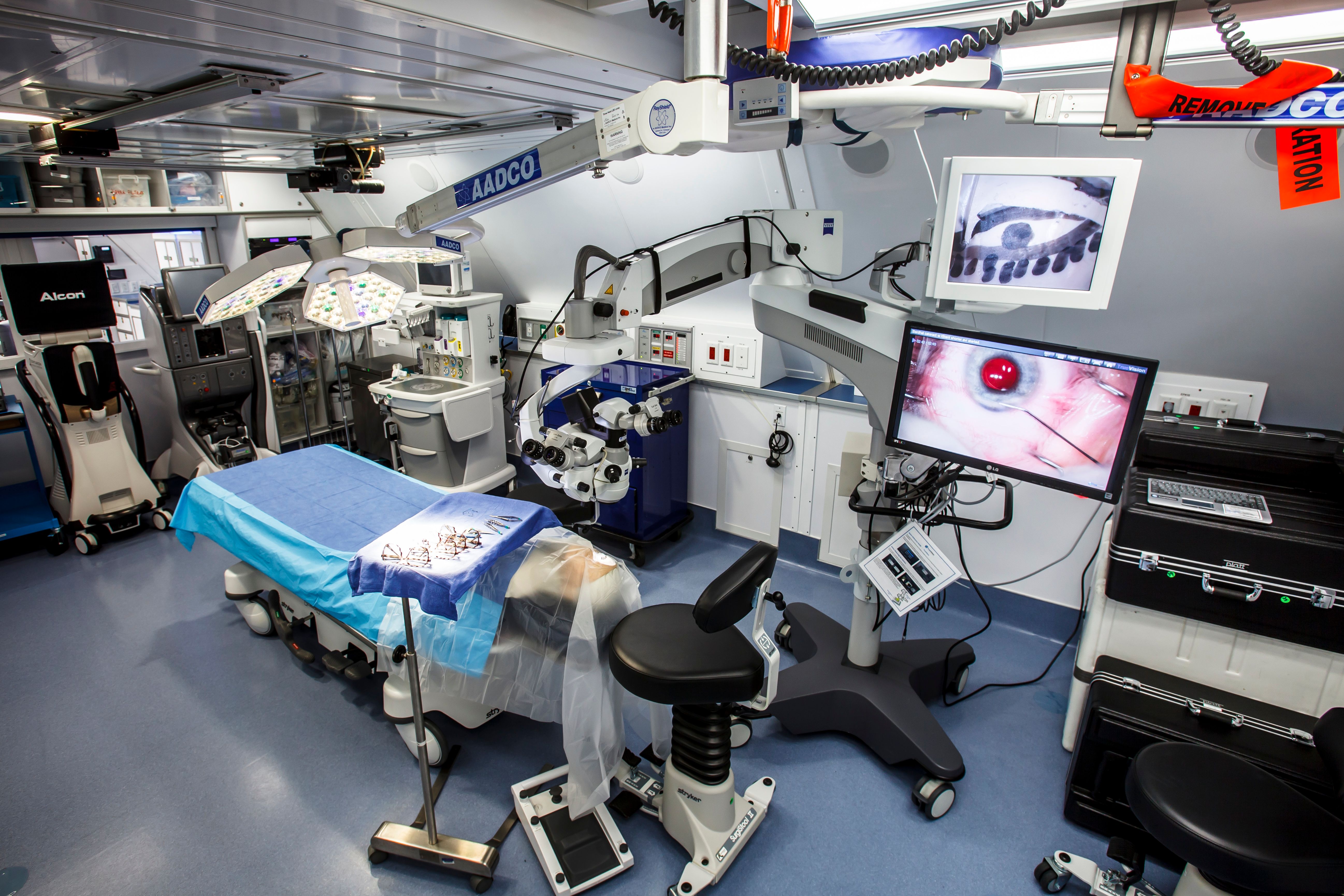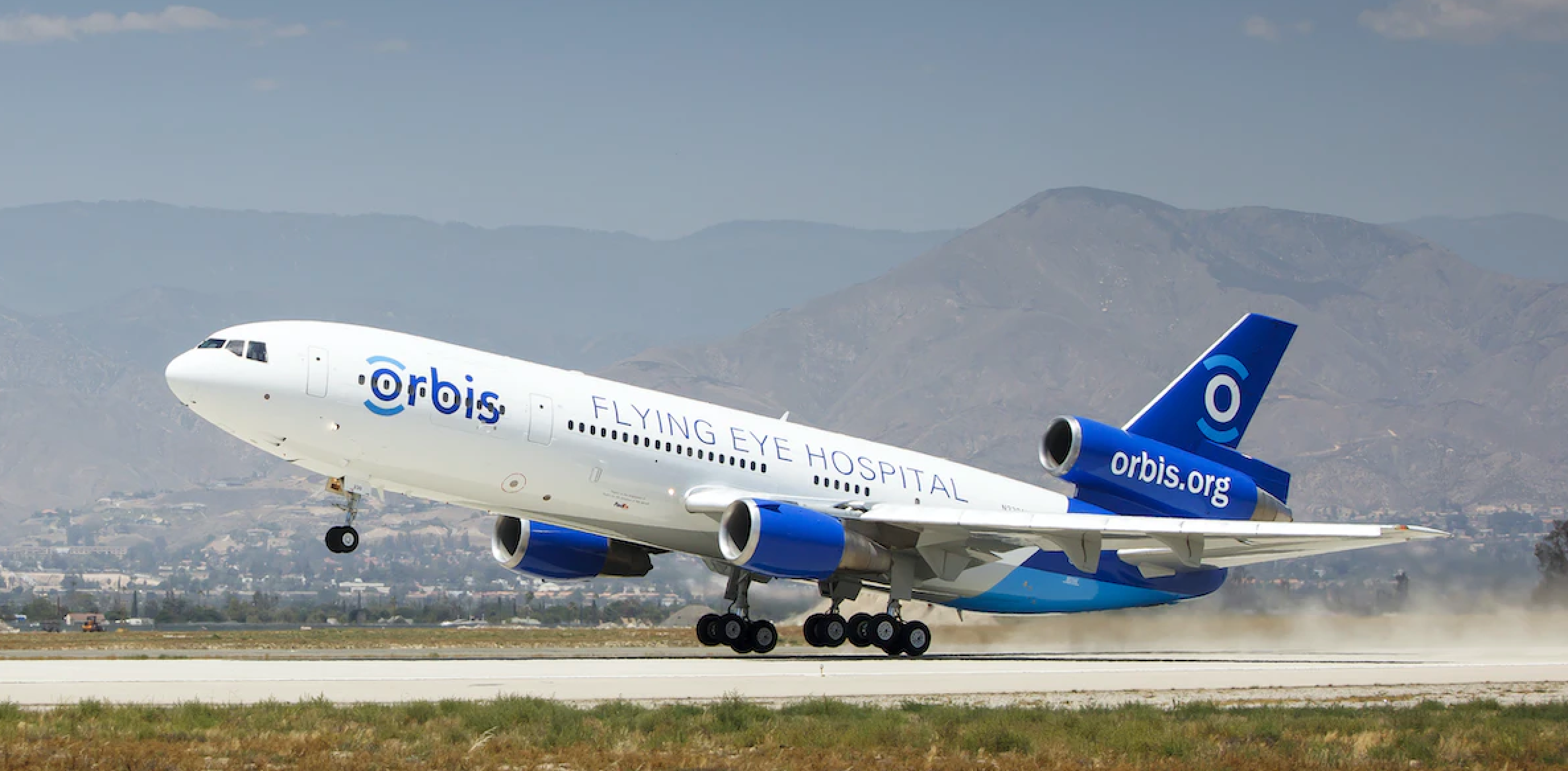Article
Boarding Orbis Flying Eye Hospital: Not your typical flight experience
Author(s):
When it is not on a mission, the Orbis Flying Eye Hospital MD-10 aircraft often is situated at an airport where the fully accredited teaching facility is put to use as a mobile simulation center to train ophthalmologists from around the world in some of the latest sight-saving techniques.
This passenger area aboard the Orbis Flying Eye Hospital doubles as a classroom when the aircraft is on the ground. (All images courtesy of Geoff Oliver Bugbee/Orbis)

It’s not American or United, but the Orbis Flying Eye Hospital is so much more, carrying on board hope and the gift of sight for patients in need of ophthalmic care around the globe.
When it is not on a mission, the MD-10 aircraft often is situated at an airport where the fully accredited teaching facility is put to use as a mobile simulation center to train ophthalmologists from around the world in some of the latest sight-saving techniques.
Maurice Geary, director of the Orbis Flying Eye Hospital, led a guided virtual tour of the aircraft that offered a glimpse into the inner workings of the Flying Eye Hospital. The craft was parked at Moffett Airfield in Santa Clara, County, California, and physicians were brought in for training.
Approaching the plane, it looks like any commercial airliner, but passing through the open door and past the flight deck, it quickly becomes apparent that it is so much more.
A comfortable seating area can accommodate more than 40 passengers and doubles as a classroom when the plane is not in flight.
“We have local physicians from our partners around the world who will come on board,” said Geary. “They will sit in the classroom here and we are able to watch the surgeries that are happening in our operating room. We are able to watch them live on the screen here at the front of the room.”
The screen at the front of the classroom is 3D, offering physicians a view that gives depth, offering them a view of what they will be seeing when they look through the microscope. All of the equipment on the Flying Eye Hospital is equipped with cameras.
The Patient Care, Simulation Training and Laser Treatment room aboard the Orbis Flying Hospital.

“What is very important to us everything that we do is focused on training. So we have cameras and all of the equipment,” Geary said. “So we can see on a monitor or on the screen here in the classroom, what the surgeons are seeing when they're looking through the microscope.
Our surgeons also are mic’d up, so they will be explaining the procedure, step by step exactly what they are doing to the to the roomful of doctors here.”
The surgical volume on the Flying Eye Hospital is kept low to ensure proper training and local physicians are in the operating room with the volunteer surgeon, as well as the observers in the classroom.
“The idea is that when we leave at the end of our project, that they either have those skills, or they have the confidence to go ahead and do those surgical procedures themselves after we're gone,” Geary said. “So everything is slowed down, and everything is focused on training. So that's really what we're trying to do with the classroom is make it a training space. So we can watch those surgeries on the screen. We have two way audio. So if we have questions from the audience here in the classroom, we can also ask those questions through a microphone and their broadcast in the operating room.”
More recently, Orbis has used its cybersites and web platforms to steam some of its live surgeries on the platform, creating a wealth of open source materials. There also is an area where medical professionals can register, we check their credentials, and they get access to things like the live surgery.
In the pre- and post-operative recovery room child patients receive Teddy bears, donated by Omega, to comfort them before and after surgery.

Just like the live surgeries, medical professionals worldwide can watch surgeries live, text questions they may have and have an experience that closely approximates the experience right on the plane.
Orbis staff also gets to double as flight attendants and train when the aircraft is restocked prior to a project.
“So we act as the flight attendants when we fly with staff on the plane,” Geary explained. “So it's kind of a unique and neat part of our job.”
The aircraft is an MD-10 that was donated to Orbis by FedEx. All of the pilots are current or former FedEx pilots who volunteer to fly the aircraft to destinations worldwide.
FedEx has proven to be a great partner and even stores the plan for Orbis between trips.
“They give us engineering and parts,” Geary added. “So really, the plane could not keep going without the support of FedEx.”
In addition to being registered as a passenger aircraft, the Flying Eye Hospital also is registered as a cargo plane. The hospital portion of the plane is made up of nine modules, which were prefabricated outside the aircraft. There are offices and an AV room.
Surgery that takes place in the operating room of the Flying Eye Hospital is broadcast live in the plane's classroom and through Cybersight, Orbis's telemedicine platform.

Surgeries are performed in a patient care and laser treatment room. This also is an area where Orbis staff will bring the patients and their family members before their surgery. And it'd be a waiting area for the family member while their relative is having surgery that day.
The area also is used for simulations during training. Artificial eyes are used to simulate surgical situations as physicians earn from training experts. During the virtual tour, physicians from Bolivia and Peru traveled to California for training on board the flying Eye Hospital.
“They're practicing their trabeculectomy on these artificial eyes all week on all of the participants will get to rotate through all of the different stations that we have on the plane this week,” Geary explained
The facility also gives many of the participants, some of whom are residents, the chance to get some hands-on practical experience they may have missed during the pandemic. Staff ophthalmologist Eduardo Mora, MD, serves as a mentor for the participants.
In addition to the latest lasers, equipment and software, the eye hospital also has a compliment of artificial retina and other models that replicate the feel of the skin to replicate macular simulations.
“We also have some of the lenses and some of the some of the artificial eyes that we use,” Geary explained “We use a lot of artificial eyes in our training these days. And there's a few companies making the artificial eyes and they make them specific to the surgical procedure. So you know, we'll be using a one eye for trabeculectomies. We have another eye for small incision, and an eye for phaco as well as an eye for strabismus.
The actual operating room is equipped with the latest surgical microscopes, phaco machines and other equipment, perfect for volunteer physicians during trips or for training. During trips, the hospital maintains a low surgical volume.
The Orbis Flying Eye Hospital is an MD-10 aircraft donated by FedEx.

“We do four or five surgeries on in a day on the Flying Hospital,” Geary said. “We will work with our local partner on assess their training needs. We will do any surgeries that they really need. So we know we can do it.”
The Flying Eye Hospital also has a clean area where instruments are prepared, sterilized and ready for surgery. A pre- and post-operative room is the area where patients are taken before and after surgery. They are monitored by anesthesiologists as they recover.
Omega donates Seymour bears for pediatric patients to make the process as comfortable as possible for the youngsters. If a child is having a procedure on the left eye a bear will be bandaged over the left eye to mirror the child’s procedure.
“The kids love it,” Geary said. “It is comforting for them to have the bear go through this experience with them.”
Earlier this year, the plane was parked in Fort Worth, Texas and ophthalmologists from the Caribbean were brought to the facility for training sessions. In October, it made its first post-pandemic trip outside the US to Qatar.
Maria Montero, MD, is the head of ophthalmology on the Orbis Flying Eye Hospital, first joined the project as a physician in 2017, focusing on anterior segment surgeries, including cataract procedures. In her current role, she oversees training and other programs as well as everything clinical with patients. She noted that a rewarding experience.
“It is amazing. I really, really love my job, I enjoy it,” she said. “I enjoy being with the residents in trainings and to see them achieve all the techniques that we are teaching them, and to witness their growth and ability to use these techniques on real patients and becoming confident enough to teach other physicians the techniques they have learned is very rewarding.”
Montero said there really is no difference in performing any of the procedures on the Flying Eye Hospital.
“Oh, it's exactly the same,” she said. “The only way you can tell you are on a plane is when you see one of the windows. It is really the only way you can tell that you are inside an airplane.”
The work also proves rewarding, especially in the form of feedback from patients treated on the Flying Hospital as well as the surgeons they have trained.
“To hear that we have made a difference is very rewarding,” she said.
Newsletter
Don’t miss out—get Ophthalmology Times updates on the latest clinical advancements and expert interviews, straight to your inbox.




